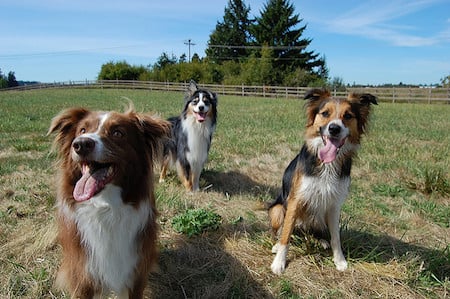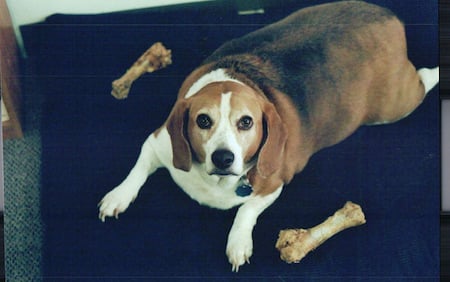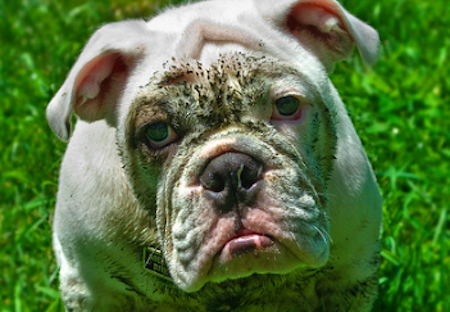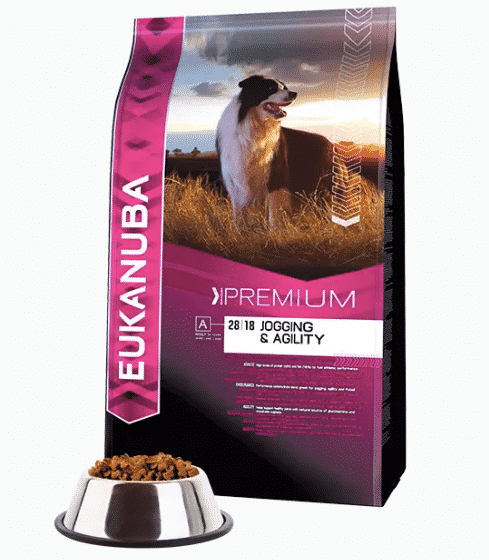Hey, it’s a great thing you’re asking the question. Many dog owners don’t pay enough attention to their dog’s body weight, and too many dogs carry extra pounds that shave months and years off their lifespans. Significant weight loss can also be cause in concern for dogs, and could point to thyroid problems, diabetes, or parasites.
Of course, you should always check with your vet, but here’s a quick guide to help you determine if your dog needs to go for a few more brisk walks, increase his doggy-biscuit intake, or continue the smart, healthy regimen you’ve established.
So Many Dog Shapes and Sizes!
Actually, before we dive in, it’s important to point out the obvious: you must take your dog’s breed and body shape into account. An English bulldog will never have the waistline of a greyhound. Even if you doubled the size of a Chihuahua, he’d still look emaciated next to a Boston terrier. So, keep your dog’s natural stature in mind, but don’t let a legitimate weight problem hide behind “stockiness.”
Vets often use a nine-point scale to assess any dog’s body weight, regardless of her breed.
A score of one indicates near-starving, while nine equals obesity-with-a-capital-O. You want your dog to fall in the middle, indicating ideal body weight. Let’s take a look at a few tests you can use to approximate your dog’s score.
Score of 1 to 3: Your Dog Is Skinny

Flickr / @Sylwia Wilska
- Your dog’s ribs are too easy to identify. They’re either visible on the dog at all times, or you feel mostly skin (no soft tissue) covering the bones.
- When feeling near the base of the tail, you feel the bones protruding, instead of a soft, smooth cushion over the bones.
- When feeling for the shoulder bones, hips, and spine, they’re very easy to find and covered with little or no fat.
- When looking at your pet from overhead, the curve between the ribs and hips is extreme, and you can see the spine or rib bones from above.
- When looking at your dog from the side, there’s an extreme rise in the abdomen from ribs to hips. This would be somewhat natural for a breed like a greyhound, but less so for a Staffie mix, which should have a more gradual, gentle rise in the abdomen.
Score of 4 to 6: Your Dog Is Just Right

Flickr / @MoodyPDX
- When feeling your dog’s ribs, you find a slight layer of fat covering the bones, but you can feel each rib distinctly.
- You feel a small amount of smooth fat over the mound of the tail where it attaches at the end of the body.
- You can find and feel the shoulder bones, hip bones, and spine, but they wear a thin cushion of fat.
- When looking at your dog from overhead, you see a slight, gentle curve between the ribs and hips.
- When looking at your dog from the side, you find a gradual rise in the abdomen from ribs to hips.
Score of 7 to 9: Your Dog Is Chubby

Flickr / @Kat
- You have to do a little (or a lot) of hunting to locate and get a feel of your dog’s ribs. If you’re not able to find the ribs at all, your dog is probably at level nine on the scale.
- You’re unable to find the tail bones when feeling the mound where the tail attaches to the end of the body.
- It’s difficult to find and feel the shoulder bones, hip bones, and spine.
- When looking at your dog from overhead, you see no waistline (or hourglass shape) between the ribs and hips. You only find a straight line or, worse, a round bubble.
- When looking at your dog from the side, you find very little rise in the abdomen from ribs to hips, or instead you find a straight line or sagging belly.
What if My Dog is Too Chubby?

Flickr / @dave koerner
If your dog falls in the chubby range, it’s time to scale back on calorie intake. Your dog’s health is your top priority so why feed her the same heavily processed food day in, day out? Make sure you design a healthy, balanced diet for your dog and stick to it. We also sometimes dole out more in treats than we realise. Investigate healthier snacks you can share with your dog, such as apples and carrots, or try low-calorie treats. Some of our favourite low-calorie dog treats include:
- Hill’s Prescription Diet Canine Metabolic Treats
- Harrington’s Low-Fat Treats
- Bounce & Bella’s Grain Free Premium Fish Treats
Exercise is key, too. Consider a dog walker if your schedule doesn’t allow for more than one walk a day!
What if My Dog is Too Skinny?
If your dog is a little bony, make sure her food has enough of the nutrients she needs—check with your vet to make sure there are no underlying health problems and get their advice on developing a healthy, balanced diet. Offer more healthy, substantive treats, like plain cooked chicken or peanut butter (make sure it’s without Xylitol which is toxic for dogs). Adding high-fat, healthy oils to her food can help, such as some coconut oil, fish oil, flaxseed oil, or even just plain olive oil. Note that too much oil can upset a digestive tract, so don’t give more than a spoonful or so per feeding, and keep an eye on how your dog reacts.
Picky eaters may like the addition of a high-calorie supplement that you can mix into their food to boost vitamins, minerals and calories.
Also, “performance” pet foods like Eukanuba, designed for active, athletic dogs, typically contain more calories and a higher percentage of protein.
If your dog has lost more than 10 percent of his body weight, there may be a health problem to address, such as thyroid imbalance, anxiety, parasites, diabetes, liver disease, or dental problems, so make sure you check with a vet to make sure your dog is healthy.
The Bottom Line
Keep in mind that puppies and younger dogs go through growth spurts and may still be growing into their bodies.
Conversely, older dogs start to slow down metabolically and physically, so it’s normal to see a little weight gain as your dog matures. Check here for breed-specific information about weight range and body shape. And be sure to check in periodically and make sure your dog is in a healthy range. If you ever need someone else to keep an eye on your dog when you can’t be there and make sure they’re eating right and getting enough exercise, check out Rover.com to find local sitters who offer dog boarding.




